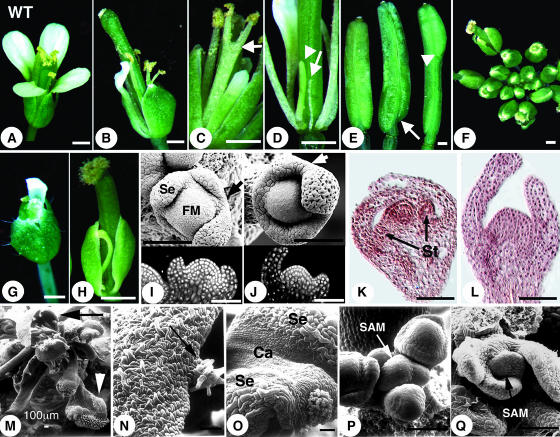Figure 1.
han Mutant Flower and Floral Meristem Phenotypes.
(A) A wild-type flower.
(B) to (E) han-2 homozygotes.
(F) to (H) han-1 homozygotes.
(B) A han-2 flower.
(C) The arrow points to the fusion of two stamens.
(D) Filamentous structures in place of a petal or a stamen are indicated by the arrow and arrowhead, respectively. Sepals were removed.
(E) Carpel defects include asymmetric silique valves (arrow) and extra carpel tissue positioned at the apical region of the silique (arrowhead). Siliques shown are not age-matched.
(F) A han-1 inflorescence.
(G) An early-arising han-1 flower.
(H) A flower with sepals all fused into an open semicircle.
(I) A wild-type stage 3 flower. Se, sepal; FM, floral meristem.
(J) A han-1 stage 3 flower (because han floral meristem development is generally delayed, floral stage is determined based on sepal size).
(K) A wild-type stage 6 flower. St, stamens.
(L) A han-1 stage 6 flower.
(M) A han-1 inflorescence at late stage. The black arrow points to a carpelloid sepal, and the white arrowhead points to a sepalloid carpel.
(N) An enlarged view of the carpelloid sepal indicated in (M). Arrow points to stigmatic papillae at the edge of the sepal.
(O) An enlarged view of the sepal (Se) and carpel (Ca) fusion structure in (M).
(P) A wild-type SAM.
(Q) A han-1 mutant SAM.
Bars in (A) to (H) = 0.5 mm; bars in (I) to (Q) = 50 μm (unless indicated otherwise).

